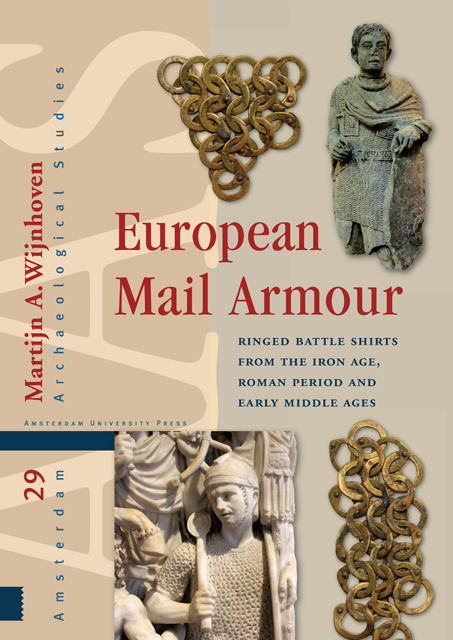Book contents
- Frontmatter
- Contents
- Acknowledgements
- Dedication
- 1 Introduction
- 2 The origins of mail armour
- 3 Distribution and archaeological context
- 4 The iconography of early mail armour
- 5 The naming of mail armour
- 6 Decoration in mail garments
- 7 Padded garments
- 8 The craft of making mail rings
- 9 Weaving patterns
- 10 The construction of mail garments
- 11 Ring characteristics
- 12 Final considerations
- Bibliography
- Database
- Appendix 1 Catalogue of mail armour
- Appendix 2 Catalogue of hybrid armour
- Appendix 3 Catalogue of isolated finds of fasteners and fixtures
- Appendix 4 Finds excluded from the database
4 - The iconography of early mail armour
Published online by Cambridge University Press: 24 November 2022
- Frontmatter
- Contents
- Acknowledgements
- Dedication
- 1 Introduction
- 2 The origins of mail armour
- 3 Distribution and archaeological context
- 4 The iconography of early mail armour
- 5 The naming of mail armour
- 6 Decoration in mail garments
- 7 Padded garments
- 8 The craft of making mail rings
- 9 Weaving patterns
- 10 The construction of mail garments
- 11 Ring characteristics
- 12 Final considerations
- Bibliography
- Database
- Appendix 1 Catalogue of mail armour
- Appendix 2 Catalogue of hybrid armour
- Appendix 3 Catalogue of isolated finds of fasteners and fixtures
- Appendix 4 Finds excluded from the database
Summary
On these stelae, all the required details of lorica hamata of the type under discussion are shown except for the rings that form the fabric of the garment itself. Anyone who has tried to draw, let alone carve in stone, the detail of a mail shirt will know how time consuming such a task can be.’
H. Russell Robinson1
THE ICONOGRAPHIC EVIDENCE
Excavated mail remains are often in poor condition, being fragmentary or corroded, which makes it difficult to make out their original shape and appearance. As will be seen in chapter 10, there are some exceptions that prove very informative, but these are still few and far between. Therefore, iconographic evidence is key to reconstructing the development of the mail coat's look and design throughout the centuries. This type of evidence includes military tombstones, state monuments and frescoes, among other imagery.
Nevertheless, iconography must be approached with caution, as what has been depicted is not always clear or reliable. Interpreting representations of mail is challenging. Even when realistically portrayed, images of mail are always simplified or stylised. Many artistic conventions were used to represent mail, from realistic to highly figurative. During the 19th century the phenomenon of artistic conventions was less well understood. Scholars of that period tended to interpret each variation as a separate type of armour, which they gave descriptive names such as ‘ringed’ or ‘mascled’ armour, and ‘single’, ‘banded’ or ‘double chain-mail’. In the early 20th century, J. Green Waller and later F.M. Kelly proved that these types were not real, but all comprised different conventions to indicate ‘regular’ mail.
Realistic renderings of mail can show individual interconnected rings, although much larger than their actual size. In many cases the weave is not properly illustrated (i.e. the 4-in-1 pattern with rows positioned horizontally; see chapter 9), and simply shown as a mesh. The more stylised images may include a number of possibilities, like circular or crescent shapes, horizontal or vertical squiggly lines, dots, circular holes, and crosshatching.
- Type
- Chapter
- Information
- European Mail ArmourRinged Battle Shirts from the Iron Age, Roman Period and Early Middle Ages, pp. 85 - 132Publisher: Amsterdam University PressPrint publication year: 2021



